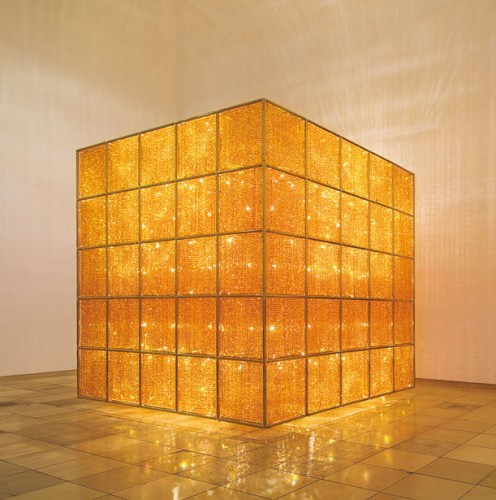In this week’s roundup Cindy Sherman arrives in Paris, Hiroshi Sugimoto tilts photos 90 degrees, Shahzia Sikander explores Islamic and East Indian art, Richard Tuttle mixes poetry and sculpture, Ai Weiwei presents his retrospective, and more.
- Cindy Sherman features a series of recent photographs on view at the Gagosian Gallery (Paris). This is Cindy Sherman‘s first exhibition in Paris following shows in Los Angeles and Rome. This series displays snapshots taken on the Capri and Stromboli islands, in Iceland during the volcanic eruption of 2010, and on Shelter Island, in New York. Afterwards, she digitally retouched them to create luxuriant pictorial effects. The exhibition closes October 10.
- Paul McCarthy‘s chess set made from kitchen items is on view in The Art of Chess at the Saatchi Gallery (London). This exhibition demonstrates the inspirational power of chess in the 21st century and how the game continues to provide an intriguing starting point for artistic expression. This show runs through October 3.
- Hiroshi Sugimoto‘s Lightning Fields and Photogenic Drawings is on view at Lille Metropole in Villeneuve-d’Ascq, France. The exhibitions present 30 large prints that are the direct result of his study of the invention and history of photography. This exhibition closes October 7.
- Hiroshi Sugimoto‘s Revolution will be on view at Museum Brandhorst, Munich, Germany. This show will feature large-format photographs of the sea at night that trace the movement of the moon over a long period. Their special presentation – the pictures being tilted 90° – creates a puzzling effect that varies considerably depending on the region in the world or the latitude. This group of works will be presented to the public for the first time in Munich. The exhibition will run October 24 – February 10, 2013.
- Shahzia Sikander is one of several artists whose works are on view in Doris Duke’s Shangri La: Architecture, Landscape, and Islamic Art at the Museum of Arts and Design (NYC). The exhibition showcases a selection of objects of Islamic art from the spectacular Honolulu home of philanthropist and art collector Doris Duke (1912-1993) and new works by six contemporary artists of Islamic background who were recently in residence there. The show closes February 17, 2013.
- Shahzia Sikander‘s The Last Post is on view at the Linda Pace Foundation (San Antonio, Texas). It features an animated video installation inspired by Sikander’s ongoing interest in the colonial history of the Indian Subcontinent as well as the British opium trade with China. The artist animates the protagonist of The Last Post, an East India Company man who appears in various guises, as dissolving, exploding, and reconstituting himself throughout the work. This work is on view through June 1, 2013.
- A Conversation with Shahzia Sikander corresponds with Sikander‘s The Last Post that is organized and presented by the Linda Pace Foundation.
- Richard Tuttle‘s Systems, VIII–XII is on view at the Pace Gallery (NYC). The exhibition features five free-standing sculptures, called Systems. His newest works center on the horizontal access and the relation with the floor. A catalogue, including poems written by the artist for each of his twelve systems created to date, accompanies the exhibition. New works pair drawings and wall-mounted sculptural elements. The exhibition closes October 13.
- Ai Weiwei: According to What? soon to be on view at at the Hirshhorn Museum and Sculpture Garden (Washington DC) will feature the retrospective and much-anticipated American debut of Ai Weiwei‘s work. First presented by the Mori Art Museum in Tokyo in 2009, it has been updated with recent works. The show will run October 7 – February 24, 2013.
- Cai Guo-Qiang is featured in the Fast Company Design magazine. An Encounter With Cai Guo-Qiang, The World’s Foremost Explosion Artist explores how the artist crosses cultural boundaries by blowing them up.
- John Baldessari‘s T is featured on the cover of T magazine. Baldessari took inspiration from his days as a grade-school art teacher when he used golf tees, which, he readily admits, made for a bad pun: a ‘‘T’’ made of tees. “The ideal form of this T,” he says, “would be that every copy of T magazine would have real tees glued onto it. But this is as close as I can come. It’s kind of like trompe l’oeil tees.”
- New York Times’ Profile in Style: Barry McGee shares a little peek into the life of Barry McGee. The profile highlights his family’s cozy Colonial Revival-style house in the city’s Mission district.




